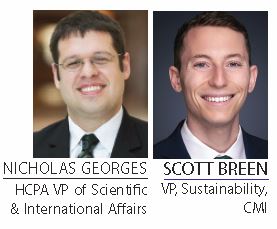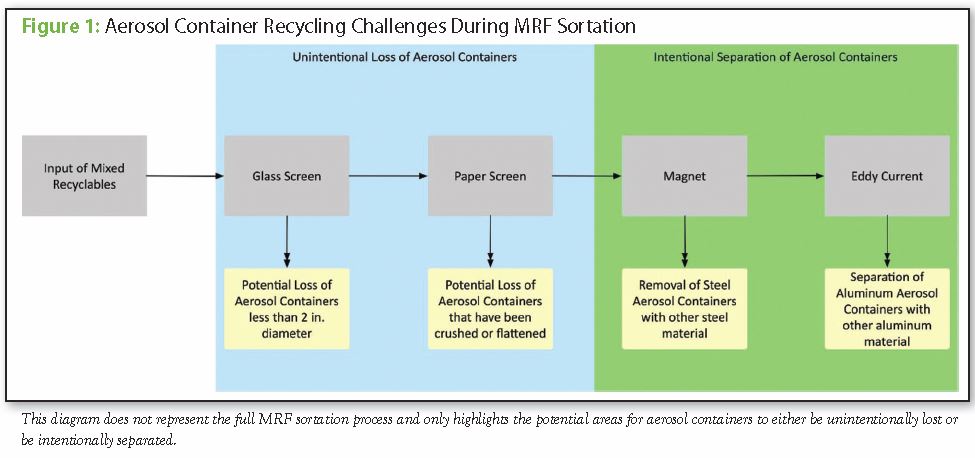Written on: April 1, 2021 by Nicholas Georges

Over the last few decades, stakeholders have discussed the best way to increase recycling rates of aerosol containers. The aerosol industry rightly maintains that steel and aluminum containers have value within the recycling stream. There have been various approaches to getting consumers and workers to recycle empty aerosol containers, but this has been complicated due to challenges with product acceptance in the recycling stream at different stages of the recycling process.
In 2016, the Sustainable Packaging Coalition published a study i—sponsored by the Household & Commercial Products Association (HCPA) and Can Manufacturers Institute (CMI), among others—that showed that approximately 70% of U.S. consumers can recycle aerosol containers curbside or at nearby recycling facilities. While the study was sufficient for aerosol product manufacturers and marketers to label their products as recyclable, it also showed that not every consumer has the ability to recycle aerosol products. We can’t reach the goal of recycling every aerosol container until every consumer has this ability.

In order to solve this problem, HCPA and CMI, along with the Pet Food Institute (PFI), contracted Resource Recycling Systems (RRS) to initiate a new study that interviewed material recovery facilities (MRFs) and end-market processors of steel and aluminum to better understand how aerosol and pet food containers are processed in the recycling system. MRFs separate materials into bales that are sold for processing. End markets then purchase the material and turn it into new products. Specifically, HCPA, CMI and PFI wanted to develop a better understanding of MRF sortation, commoditization and end-market acceptance, as well as learn about specific technical hurdles that impede recycling.
RRS interviewed 13 MRF operators, including representatives from two of the largest MRF operators in the U.S. The majority were single-stream facilities, the primary type of MRF in the U.S., and the rest were dual stream. The mix of small and large operators collectively represent approximately 25% of MRFs and approximately 50% of the tonnage of recyclables that are processed in the U.S. RRS also interviewed representatives and experts in both the steel and aluminum end markets.
In February, RRS presented its findings and provided an overview of a typical large material recovery facility sortation scheme, real and perceived safety concerns of handling aerosol products and recommendations to improve the recycling of aerosol and pet food containers.
Of the MRFs that RRS interviewed (some had multiple locations), nine explicitly accept ii steel aerosol containers and 10 explicitly accept aluminum aerosol containers. Additionally, RRS interviewed two national MRF operators, neither of which prefers to accept aerosol containers.
In a typical MRF, there are some instances where aerosol containers could “fall through the cracks,” including:
• Small aerosol containers, particularly those with a diameter of less than 2″, may be lost during the sorting process by falling through a screen that is meant to remove glass;
• A container that has been crushed flat and thin has the possibility to be lost when the sorting process is removing paper material.
Metals are usually separated out at the end of the MRF’s sortation process. Typically, the first stage is the use of a magnet to remove steel items, including steel aerosol containers. MRFs reported that they are confident that the magnet captures all steel aerosol containers. Once the steel is separated from the rest of the recycling stream, it’s baled and sold to brokers and scrap managers for further processing at market price. Steel end markets readily buy bales that contain aerosol containers—there are no penalties, price downgrades or rejections for steel bales that contain them. Flammability from steel aerosol containers is not a serious concern, as any potential non-empty product would likely have been discharged during the baling process. Plastic parts and paper labels are also not a problem for steel end markets and can even be a positive due to the energy that they add to the heat process.
RRS found that aluminum aerosol containers pose more challenges to sort and recycle than steel. The good news is that aluminum aerosol containers that reach the eddy current iii are likely captured. Some MRFs include aluminum aerosols in bales of non-used beverage container aluminum products. These bales are known as mixed aluminum bales and are sold at a notably lower price than used beverage can (UBC) bales. This is because aluminum mills that make aluminum beverage can sheet only want the alloy in beverage cans and may reject or pay less for a bale that has too many non-UBCs. Finally, some MRFs manually remove all non-UBC aluminum, including aerosols, and send them to residue (disposal) due to safety and/or or end market concerns.
While MRFs that don’t sell mixed aluminum bales likely send aluminum aerosols to the landfill, those with the volumes, storage space, processing capacity and willingness to create mixed aluminum bales have several ready end markets. Aluminum aerosol cans that go to end markets are suitable for remelt scrap ingot (RSI) or deox production. RSI is aluminum scrap recycled into an intermediate product without highly specific chemical and physical properties. A customer buys the intermediate product, remelts it and adds alloys to meet the chemical specifications of the desired end product. Deox is a steel additive that is used during the steel-making process. While the recycled aluminum is no longer recyclable after being used to produce deox, the recycled aluminum is important as it reduces the amount of virgin aluminum or other additives needed. Plastic, paper and moisture can cause concerns with both deox and RSI because of flammability potential. Contamination from other metal, such as steel, is also an issue as steel melts at a higher temperature than aluminum.
RRS also provided potential recommendations to improve the recycling rate of aerosol containers:
• Further interview national MRF operators to better understand their concerns (e.g., flammability) and how to address them;
• Develop a priority list of MRF operators to discuss acceptability of aerosol containers when their contracts come up for renewal;
• Conduct studies to measure and assign value to the amount of material lost in the sorting process;
• Launch a non-UBC aluminum recovery consortium to help leverage joint investment to scale solutions and intermediate processes to clean and prepare non-UBC material for end markets.
The findings from this research will better inform the next steps of the project to increase aerosol container recycling so we can reach the goal of recycling every aerosol can. For more info or to get involved, contact Nicholas Georges (ngeorges@thehcpa.org) or Scott Breen (sbreen@cancentral.com). SPRAY
i Sustainable Packaging Coalition: 2015-2016 Centralized Study of the Availability of Recycling for Aerosol Containers. link
ii Explicitly accepted means that the MRF either specifically states in their contract or on community outreach materials that they accept aerosol containers.
iii To see what an eddy current looks like, go here.